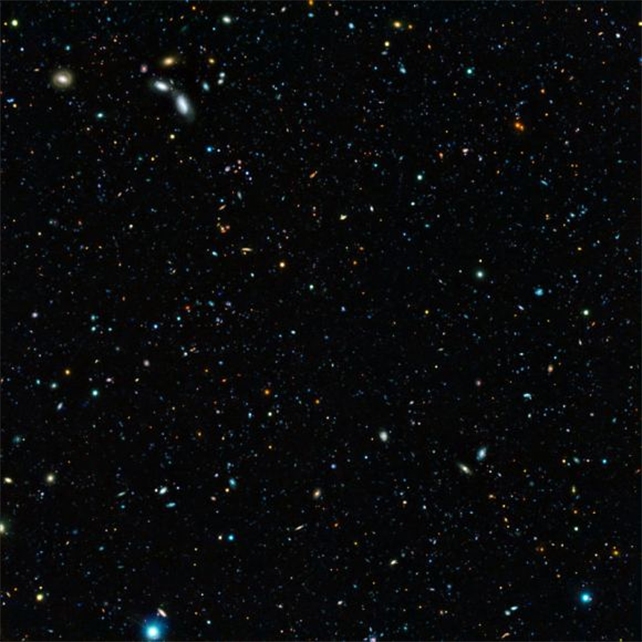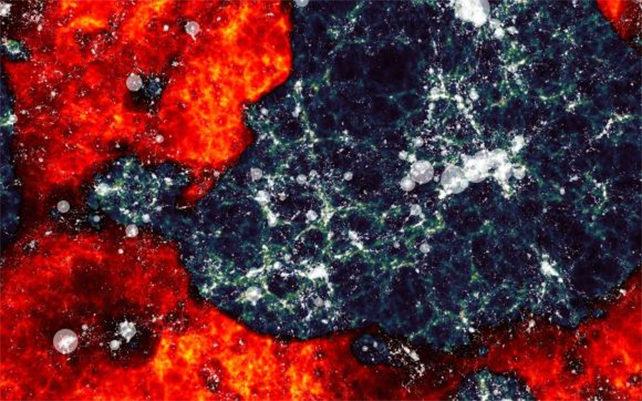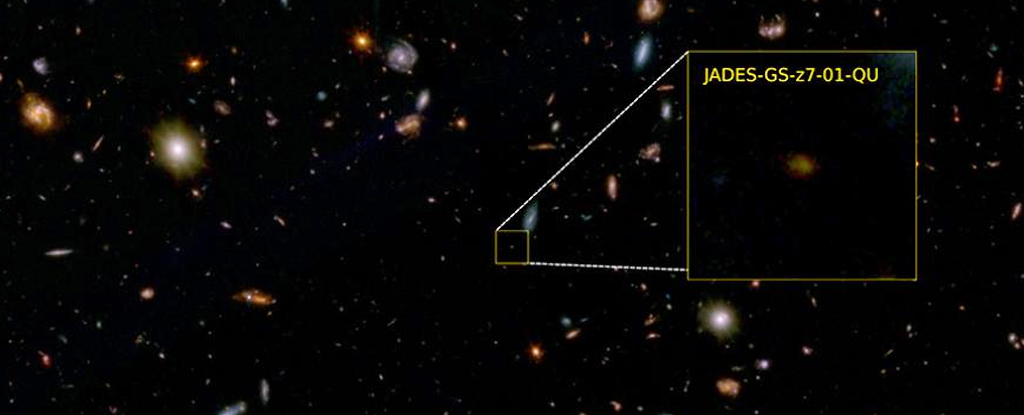Products You May Like
When a galaxy runs out of gas and dust, the process of star birth stops. That takes billions of years.
But, there’s a galaxy out there that was already dead when the Universe was only 700 million years old. What happened to it?
That’s what an international team of astronomers wants to know.
“The first few hundred million years of the Universe was a very active phase, with lots of gas clouds collapsing to form new stars,” said Tobias Looser from the Kavli Institute for Cosmology at the University of Cambridge.
“Galaxies need a rich supply of gas to form new stars, and the early universe was like an all-you-can-eat buffet.”
So, when the galaxy JADES-GS-z7-01-QU showed up in a JWST observation, it didn’t exhibit much evidence of ongoing star formation. (JADES stands for JWST Advanced Deep Extragalactic Survey.) It’s in what astronomers refer to as a ‘quenched’ state and looks like star formation started and quickly stopped.
Figuring out why this happened to the young galaxy is an important step in cosmology. Why did it stop creating stars? And, were the factors that affect star formation the same then as they are today?

When a Galaxy Stops Forming Stars
Star-formation quenching is something astronomers don’t expect to happen quickly.
“It’s only later in the Universe that we start to see galaxies stop forming stars, whether that’s due to a black hole or something else,” said Dr Francesco D’Eugenio, also from the Kavli Institute for Cosmology and a co-author with Looser on a recent paper about JADES-GS-z7-01-QU.
Star birth usually begins as clouds of gas coalesce together. Gas-rich regions, including galaxies, are prime spots for star-birth nurseries. JWST data about JADES-GS-z7-01-QU shows that this baby galaxy experienced a very intense period of star formation shortly after it began forming (after the Epoch of Reionization). For somewhere between 30 to 90 million years, it was ablaze with star formation. Then, suddenly, it stopped.
That’s not surprising – although astronomers aren’t sure why it stopped. Clearly, it ran out of gas. Maybe a supermassive black hole at its heart gobbled up much of the available “star stuff”. The black hole’s rapidly moving winds and jets could also have shoved a great deal of the star-birth material completely out of the galaxy.
It’s also possible that the very rapid pace of star formation that JADES-GS-z7-01-QU experienced simply used up the supply. That’s not impossible, according to Looser.
“Everything seems to happen faster and more dramatically in the early universe, and that might include galaxies moving from a star-forming phase to dormant or quenched,” he said.
Figuring out the answer
It’s not clear from the current JWST data what happened to this little galaxy back at the dawn of time. Astronomers are still probing the data.
“We’re not sure if any of those scenarios can explain what we’ve now seen with Webb,” said paper co-author Professor Roberto Maiolino.
“Until now, to understand the early Universe, we’ve used models based on the modern universe. But now that we can see so much further back in time, and observe that the star formation was quenched so rapidly in this galaxy, models based on the modern universe may need to be revisited.”

That means more observations using JWST.
“We’re looking for other galaxies like this one in the early Universe, which will help us place some constraints on how and why galaxies stop forming new stars,” said D’Eugenio.
“It could be the case that galaxies in the early Universe ‘die’ and then burst back to life – we’ll need more observations to help us figure that out.”
There’s one other possibility that astronomers will want to probe. JADES-GS-z7-01-QU looked dead at the time of its life when JWST observed it. But, it’s possible that the star-birth quenching was only a temporary thing. Maybe it was caused by periodic outflows of star-stuff material to interstellar space (driven by the black hole in the nucleus). Other galaxies have also been observed to be taking a star-birth break, but they’re much more massive than this one.
Perhaps JADES-GS-z7-01-QU started up the star-forming factory later in its history. In that case, it could well have grown much more massive in later epochs of cosmic history.
And, this provides an intriguing idea: perhaps other “quenched” galaxies also took a break, then got a massive infusion of gas –perhaps through collisions with other galaxies – to create later generations of stars. Future JWST observations should uncover more of these galaxies and that should allow astronomers to study their quenched phases in more detail.
This article was originally published by Universe Today. Read the original article.
